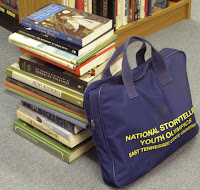 I know I’m on the hunt for a good story when my eyes dart from bookshelf to bookshelf and the musty smell of used books fill the air. Sometimes a mysterious light shines through a window and rests upon a leather-bound book. Libraries and bookstores can be heaven to those who know the secrets of storytellers.
I know I’m on the hunt for a good story when my eyes dart from bookshelf to bookshelf and the musty smell of used books fill the air. Sometimes a mysterious light shines through a window and rests upon a leather-bound book. Libraries and bookstores can be heaven to those who know the secrets of storytellers. Warning: Going through libraries and bookstores can cause your arms to be tired from carrying so many amazing books. If you are like me, then bring a HUGE bag to carry the 30-60 books that you will bring home. Better yet, bring someone to carry the books for you.
If you followed me into a library/bookstore, my destination would be the 398.2 sections, also known as the places for folktales and fairy tales. I say “places” because you can find 398.2 in the children’s area as well as the adult’s area.
Finding the Perfect Story:
- Decide on Genre and/or Subject Matter
- Skim Titles
- Focus on Books with Story Collections
- Read Story Over a Dozen Times
Decide on Genre and/or Subject Matter
Simply heading toward the folktales and fairy tales does not narrow down your search. Within this area, you will still come upon story genres such as ghost stories, tall tales, trickster tales, healing stories, creation/natural stories, quest stories, fantasy, wisdom tales, fables, myths and legends. If you are unsure as to what interests you, then create a list of what does not interest you. Reading a story that fits within each of the genres could give you an idea of what you like and dislike, too.
I have more fun focusing on a subject matter. Maybe one of your favorite animals is the rabbit. A whole one-hour storytelling program could be easily dedicated to rabbit stories from around the world. Perhaps you would rather aim for tales that reflect mother/daughter relationships. You may discover that what you value today is as precious in any culture or time period.
Skim Titles
For a first time perusal, I go to the 398.2 in the children’s area. Due to the picture books, I am able to glance at titles and see what captures my interest. With a genre or subject in mind, then I train my eyes to search for word(s) connected to those topics. When a word or two catches my attention, then I stop, pull out the book, and flip through some of the pages.
Focus on Books wi th Story Collections
th Story Collections
I prefer the books that have more than one story. Some of the best story collections are published by August House or gathered by Margaret Read MacDonald. I recommend being familiar with fairy tales/folktales collected by Andrew Lang like the Red Fairy Book, Orange Fairy Book, Green Fairy Book, and so on. I love finding stories that the average person would not know. The used bookstore is one of the best places to find unfamiliar tales.
Read Story Over a Dozen Times
I would not expect you to read a story twelve times while at the library/bookstore. The place is only open for some many hours of the day. Take the books home and find a reading-friendly room. The story is “golden” if you love the story after reading it at least 12 times.
Once you have the perfect story, then you are ready to tell the story in your own voice.
Until we tell again,
Rachel Hedman
Professional Storyteller
Co-Chair of Youth, Educators, and Storytellers Alliance
(801) 870-5799
rachel@storytellingadventures.com
http://www.rachelhedman.com/
http://www.yesalliance.com/












